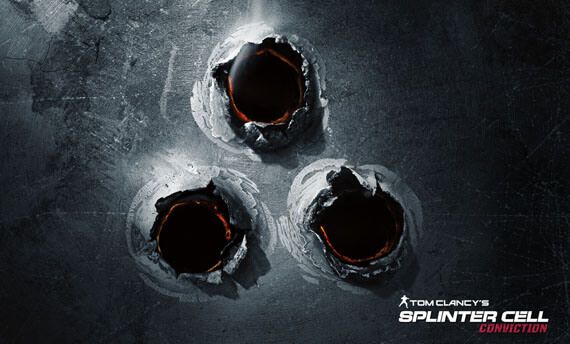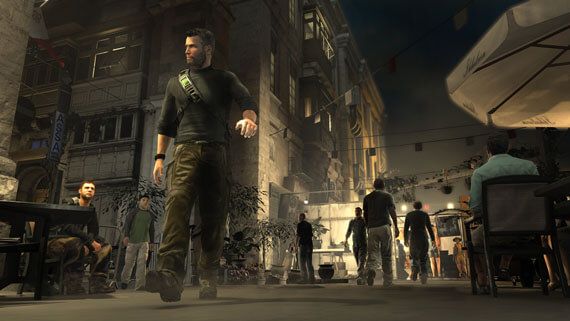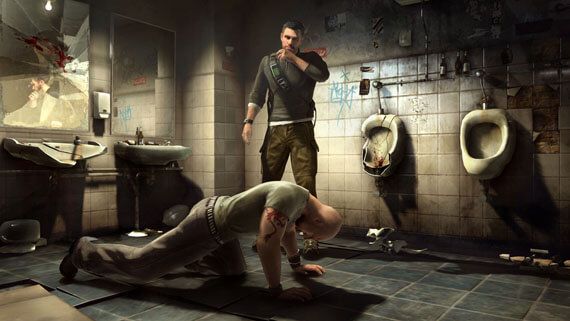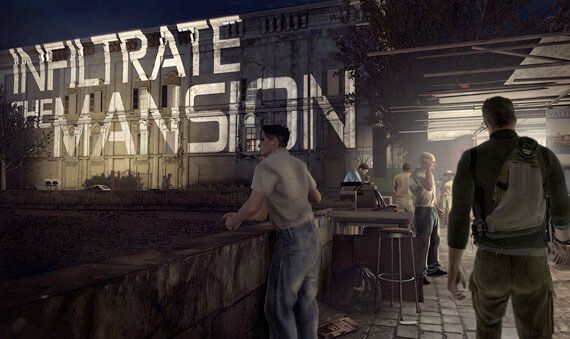Short Version: Splinter Cell: Conviction looks amazing and plays extremely comfortably. The rich world is incredibly engaging and believable from start to finish. The story is a bit short and predictable, but it's told in interesting ways that add even more to the overall graphical flair of the game.
To say Splinter Cell: Conviction is an experience is putting it a little mildly. The game has style, and lots of it. From the moment the game started to the gripping moments where it ended, the game was so incredibly natural that I couldn't shake that giddy feeling that accompanies awesome games. I found the game incredibly easy to pick up and play and difficult to put down. Players new to the Splinter Cell universe are quickly brought up to speed on Sam Fisher's life and the bits of story from the previous games that are important to know for this one. Anyone who hasn't played the other Splinter Cell games will find that Conviction doesn't treat them like experts, but instead eases them into the gameplay at an easy to follow pace.
Graphics
I'd like to start by praising Splinter Cell: Conviction's art direction. The Splinter Cell series has always been known for its fantastic use of lighting, and this installment continues the trend. Lighting is more than just a gameplay mechanic; it looks amazing. Ubisoft's LEAD engine truly shines most, if you'll pardon the pun, with its dynamic lighting. Lights that move cast shadows realistically, which is nice when you have several guards exploring a darkened room with flashlights. Light, of course, is not complete without dark, and the dark provides the player with a lot of interesting choices. You can hide in the shadows and play in a more predatory role, or you can run into the light guns blazing and beat the odds. Don't like the light? No problem! Shoot out the lights to create darkness to hide in.
Why you'd want to play in darkness is beyond me, since all of the locations are incredibly detailed. No interior or exterior in the game is bland. Every room or street is populated with the things that you should find in those places. Nothing looks out of place, everything just seems to belong. Offices are littered with all the things you would expect to find in them, not just a desk, a telephone, and a computer monitor. Exteriors are richly designed, and all seem to take advantage of the sun and moon for creating atmosphere in the lighting. The rich visuals of the locations are complemented extremely well by the detailed citizens that populate them. Civilians even have realistic conversations that are appropriate for the situation they're in. One in particular, late in the game, had me in shock as the NPCs moved around during their discussion and interacted with each other instead of just standing there.
Gameplay
The natural feel of the game is prevalent throughout the entire experience. I don't use the term "best ever" lightly, but the cover system in this game is up there with the best I've ever encountered in a video game. Yes, even better than that of Gears of War. Getting behind cover is as simple as holding the left trigger, similar to that of the Rainbox Six Vegas games (also by Ubisoft). If you need to make a quick escape, detaching yourself from whatever rock, wall, or tree you're attached to is as easy as letting go of the trigger. It doesn't seem like much on paper, but in practice it makes moving around during an intense fire-fight much easier. While in cover, your options for cover to cover movement are shown dynamically as you look at different cover providing objects. Want to run to one side of car and not the other? Not a problem, you can choose to send Sam right where you want him to go.
Sam himself controls like a predator. His movements are quick but stealthy. I had no problems moving in and out of shadows, and I never felt like I had to wrestle with the controls to pull off complex maneuvers. If I didn't manage to escape or move to the right spot, blame was solely on my own shoulders. Knowing when you're hidden has been simplified for ease of use. When you're in light, the world around you is vibrant and colorful, but when you're hiding in the shadows the color fades out to a monochrome. At first I absolutely loved this touch, and felt it made everything that much more gritty while I was sneaking around levels. But as I played more, I took issue with the way the sudden loss of color sometimes meant it was hard to differentiate enemies from their backgrounds, especially during the missions that take place outdoors with lots of foliage.
Click here to continue to page two of Game Rant's Splinter Cell: Conviction review.
Conviction introduces players to the Mark and Execute system. Targets can be marked any time they are in line of sight. The mark will stay above their heads even if they move out of line of sight. This gives you some tactical advantage, since you can see where the enemy is moving, even when behind a wall. To execute marked targets, you first have to kill an enemy in close combat. If you're able to execute a target, his mark will turn red, and at the touch of a button Sam will take him down. Different weapons have different restrictions on how many targets can be marked at a time, which means a lot of the time you're prioritizing targets to make sure the biggest threats go down first. When the Mark and Execute ability was revealed there was a lot of discussion about whether or not it would make the game too easy, and I can say for sure that it often doesn't. To be able to Execute, you need to enter close combat, and quite often that isn't as easy to accomplish as you might think. Overall, the new system feels balanced and intuitive.
The upgrade system for your weapons in Conviction is pretty cool, but very simplistic. By completing certain tasks and performing certain kill types repeatedly, you're able to earn points which let you buy upgrades for your guns. The upgrades are fairly simple, but definitely improve the overall distinction between similar weapons, and help to give them utility accordingly. As an example, one of my submachine guns can be silenced with a scope, while another does more damage and has a laser sight. Each one is more in tune with a different approach to the game, giving me options for tailoring my weapons to my play style.
Sound and Music
While enemies blend into the background as you're hidden, the music does a great job of blending itself into the background throughout the entire game. The music is the only thing that didn't stand out for me while playing Conviction. All the tracks just seemed to be there, and none of them really came off as rich or as textured as the game which they represent. Instead, the music just seems to fill dead air. While I didn't much care for the tracks I was hearing, I did like the way music serves its own practical use in the game. The transition between soft music during the peaceful portions of the game and more uptempo music during combat is seamless, and helps to enhance your awareness of your surroundings.
Story
The story may not be particularly ground breaking, but the way in which it is told definitely left an impression on me. Flashbacks are shown to you as old film grain videos, which are displayed on walls or on objects around you, as if they're being illuminated by some invisible projector. Similarly, your objectives are constantly being shown to you in the environment, as if to constantly keep you on track. Not that it's needed. With the press of the back button, your objective is projected right in front of you on the ground. Walk up to it and it'll actually project onto Sam as well.
The plot of the game is a little simple, and if you're an experienced gamer, perhaps even a little predictable. Interestingly, the story is broken up a couple of times to show short clips from a future point in the story. The asynchronous storytelling really helps break up the frenetic pace of the game by separating levels. On top of these breaks, some levels are introduced by Sam's old squad partner Victor Coste, as he recounts all the events of Conviction for a video camera.
Conclusion
Splinter Cell: Conviction has a lot to offer, despite a short campaign. The ability to complete missions both overtly and covertly definitely gives the game some re-playability. Mark and Execute is a great mechanic that adds a little more strategy to how you play by giving you the option to instantly kill certain targets. The cover system is easily the best in any game to date, rivaled only by Gears of War. The music for the game could use a little work, but it serves its purpose well all the same. Finally, the visuals are some of the best of any game on any console. The game immerses you from start to finish in beautiful and real looking locales which are populated by believable characters. Every location feels like it could be a real place that had been simply injected into the game.
The single player campaign, of course, is just one of the game's campaigns, so be sure to check out the co-op Deniable Ops as well.
Splinter Cell: Conviction is available now on the Xbox 360, and will be released April 27th on PC.




